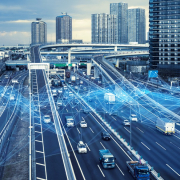Make Sure Today’s Infrastructure Design Supports Tomorrow’s Tech

Written by Ron Tellas
What happens when a smart building doesn’t have a high-performance infrastructure working behind the scenes to handle power and data-transmission needs quickly and efficiently?
Bandwidth bottlenecks and latency issues, device and system malfunction, and user inefficiency are sure to be the result.
Smart Building Infrastructure Design Considerations
Every smart building is unique based on the goals its owner mapped out (operating-cost improvements, energy-efficiency gains, employee-satisfaction growth, etc.). These distinct objectives help identify the technologies, systems, and devices that should be deployed and integrated throughout the smart building. From there, the right cabling and network infrastructure can be designed to support data access, software platforms, and protocols.
Planning a connected infrastructure for a smart building requires many considerations for each application.
Cabling and Connectivity
Selecting the right cable type depends on several factors, including performance and bandwidth requirements for current and future applications, distances between telecommunications rooms (TRs) and devices, power requirements, and costs.
Most smart buildings rely on a mixture of cabling types:
- Balanced twisted-pair copper cabling (Single Pair Ethernet or four-pair Category cable)
- Fiber optic cabling (singlemode or multimode cable)
- Hybrid fiber-copper cable
- Specialty cables (RemoteIP Cable, Fault-Managed Power Cable, etc.)
Work Area Outlets vs. Service Outlets
There are two types of work area outlets to consider:
- Telecom outlets (TOs)
- Service outlets (SOs)
TOs are used in locations where devices are administered by the user (a laptop or IP phone). SOs connect to more permanent devices that are for a specific application or remain in a certain location (security cameras, wireless access points, etc.). They also support modular plug terminated link (MPTL) topology, which allows horizontal cable to be terminated on one end to an RJ45 plug that connects directly to a device.
Pathways and Spaces
ANSI/TIA-569 provides general requirements for pathways and spaces, while ANSI/BICSI-007 covers TR layout and size options. Best practices dictate that pathways and spaces should accommodate future growth of at least 50%. (If you’re renovating an existing facility, however, this isn’t always possible.)
Possible scenarios include:
- A single TR to house telecom equipment and specialty systems, with the core network located in racks in the middle of the room
- One TR for the core network and one TR for the other systems
Remote Power
Connected devices in smart buildings require low-voltage DC power. PoE and SPoE (Single-Pair Power over Ethernet) that deliver DC power to devices over twisted-pair copper cabling are considered Class 2 power-limited circuits, defined in the National Electrical Code’s Article 725. Class 2 power can also be delivered via hybrid fiber-copper cabling. Some devices, such as those used in professional sound, AV, security, and life-safety systems, are powered via Class 3 power-limited circuits. Both Class 2 and Class 3 circuits limit power-source output.
Another way to deliver power to devices in smart buildings is through fault-managed power (FMP), or Class 4 power. In these systems, the circuit is continuously monitored for fault conditions. Fault detection stops the flow of electricity within milliseconds.
Like Class 2, Class 4 can be deployed using hybrid fiber-copper cables that bring power and data together over long distances using a single cable run.
Evaluate the Connectivity Capabilities of Your Smart Building
Smart-building owners need to not only invest in high-performance infrastructure but also be confident that the infrastructure will operate at its full potential. That way, systems, devices, and people can communicate and connect to the information they need.
This confidence comes in the form of certification, achieved through testing which proves that the mission-critical infrastructure operates as intended.
Just like cabling systems can be certified for performance, smart buildings can also be certified for their intelligence and functionality.
Get to Know SPIRE
SPIRE™ (Smart Buildings Assessment and Rating Program)—a collaboration between TIA and UL Solutions—is an assessment and rating program designed to help owners verify that their building’s systems are integrated to share data and be managed across a single interface.
First launched in 2020 and updated in 2023, SPIRE offers a framework that connects owners with technology-agnostic metrics they can use to evaluate building systems, processes, and infrastructure in six areas:
- Connectivity
- Cybersecurity
- Health and well-being
- Life and property safety
- Power and energy
- Sustainability
SPIRE’s connectivity assessment criteria is used to verify the intelligence of the building. It evaluates five areas to make sure the smart building can effectively and efficiently connect and power more people and more IT and OT devices.
- Media: Assesses the bandwidth and low-power delivery capabilities of media installed throughout the building.
- Coverage: Assesses support and coverage for IT-OT convergence throughout the building and property.
- Security: Assesses physical security of building connectivity, infrastructure, and related assets.
- Expansion: Assesses the ability of connectivity, pathways, and spaces to support expansion.
- Resilience: Assesses connectivity redundancy and the policies and procedures surrounding the ability of critical operations to continue functioning during an event.
Your Resource for ICT Infrastructure in Smart Buildings
Following best practices and standards to design smart building connectivity infrastructure is essential for a futureproof facility.
Making the right decisions requires a trusted advisor like Belden. We understand smart buildings and are at the heart of this technology transformation. Our team is here to help you make your smart building safer, more comfortable, more resilient, and more cost-effective.
If you want to read more about the topic of designing and selecting ICT infrastructure for smart buildings, read the latest issue of ICT Today, which features an article penned by contributing members of CCCA’s New Technology & Trends Committee, including Belden.
Learn more about our smart building solutions.
Find the original article here





